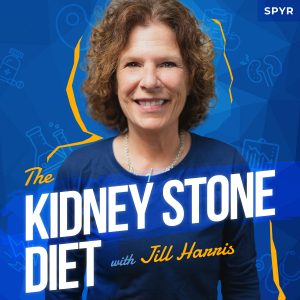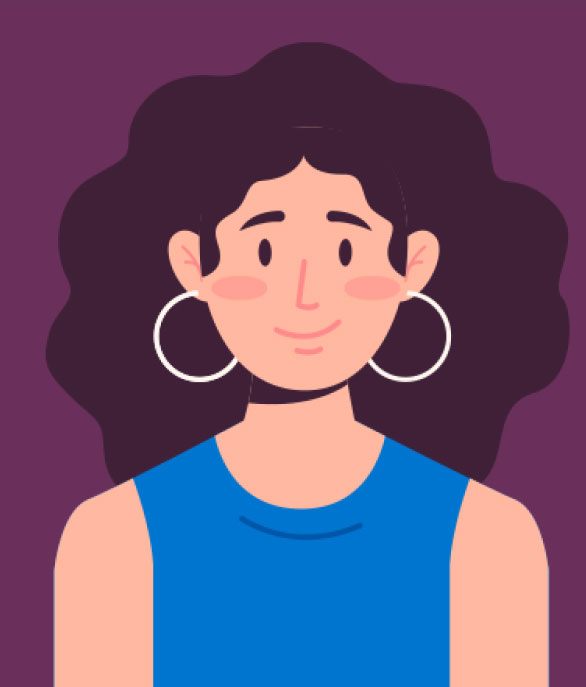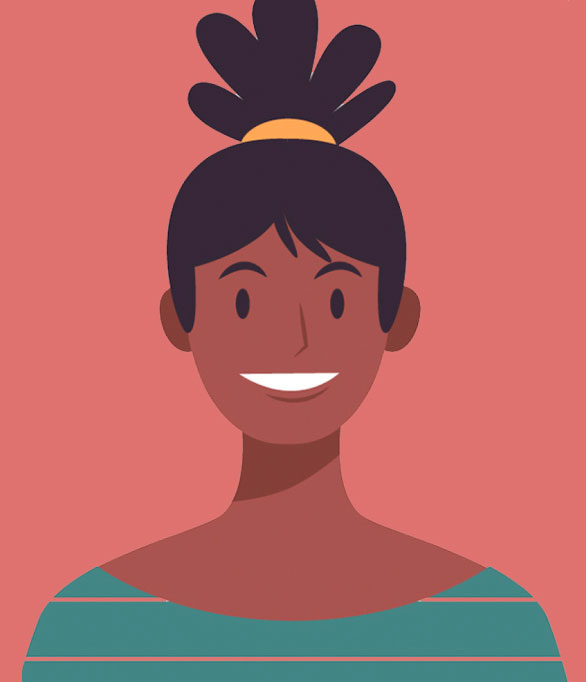This week, Jill answers a listener question about oxalate and why they may appear to be less common in some regions.
Jeff Sarris: Welcome back to the Kidney Stone Diet podcast, the show about reducing your kidney stone risk and living your best life. I’m your host and fellow student, Jeff Sarris.
Jill Harris: And I’m Jill Harris, your kidney stone prevention nurse.
Jeff Sarris: Got a little jingle today, I like it. It is beautiful out today. We have not been able to say that for–it feels like forever. It’s only been like a week and a half.
Jill Harris: You know, at some point, you’re like, “Well, you live in Illinois, come on!” You think you’d be used to this after decades, but you’re never used to it. Because one day it’s truly 30 degrees and you have a parka on, and the next day you’re like, “Oh my god, where’s my fan?” Tomorrow’s gonna be 87 degrees! And it’s just like, how can it possibly be that moody? That’s all I’m saying. It’s wild, it’s wild. So yesterday was nasty, but we’re going on a whole week where it’s going to be nice, so it makes the potty training process so much more bearable.
Jeff Sarris: Yeah, how is that going?
Jill Harris: Oh my god! So I love him so much. I love him, but he’s a handful. He’s eight pounds now. So, he’s grown under my care. He’s growing. You look at him and you’re like, “Oh, he’s the most adorable thing ever!” But he has eyes like this. “I’m that adorable and I won’t get you!” He’s just all over the place, but all in the best ways possible. Like, I really appreciate his nature. He’s a good dog, but he’s also very mischievous and that’s right up my alley. I love it. I never know quite what he’s gonna do, so it keeps it interesting. He’s super smart. He knows how to sit already. He knows how to come already. I have decided that if your dog is peeing in the house–don’t give me any hate mail, people. I’m not saying 100% of the time. I’m just saying most of the time if the dog is having accidents in the house, unless they’re a certain temperament, it’s because you’re not paying attention, right?
So, every time I don’t pay attention to him, he’s peed in the house. But, because I’m a drill sergeant, that only happens like once every three days. I mean, so he’s been awesome. You know, he’s crate trained, which is amazing, so when I’m busy working, he goes in his crate. He doesn’t make a peep. I feel like my life is too good to be true. And I know, people, right now, the viewer is like, “Okay, tick tock, girl and boy, I was here for kidney stones. Why are we always chatting at the beginning?” Because we are chatting! Talking about dogs, what’s not to love? How are you doing in the midst of still missing your little guy? Have you adjusted ok?
Jeff Sarris: Yeah, it becomes more and more normal every day, but yeah, it’s still hard. Like, I wish he was still here. Not really too much to say about it. I’d like to have him here, but he’s not. And just accepting it. I think I said last time, but I wear this little brown bracelet, it’s the same colors as him. It’s just a little reminder every day, put it on in the morning, and take it off before bed. It’s just kind of just what I decided to do.
Jill Harris: I love that you did that, first of all. We all know you know what I did. Of course, I took it to the extreme and got a tattoo of him, of course. But here’s the thing, what I found and tell me how you feel, during the process–and we will be talking about kidney stones a second–but during the process of grieving, losing in this case Jeff’s cat and in this case, my dog, Luke, it’s just interesting to watch oneself in the process of it all, you know. It’s just an unbearable thing at the beginning and as the days go on, I think you used the best word possible because you never really get over it. You’re never like, “I’m fine with it.” But I think you just do accept it and now this is your life without that beautiful animal, right? So it is such an interesting process to pay attention to. Notice who you are in that process, how it’s affecting you, it’s just very interesting to me, you know?
Jeff Sarris: I think when it does impact you a lot, it also really drives home what the animal–obviously, like a human or whatever, whoever you’re sort of grieving over–how much they meant to you. And I think that there is a little almost solace there, too, because you know it, but then you like, “feel” it. You’re like, “Oh, yeah. This was an important part of my life.”
Jill Harris: It is amazing how much animals can bring to our life. They don’t talk. To me, that’s a bonus, so I really appreciate that. But, I mean, imagine the love you’re getting from something, in this case an animal, and they don’t even talk to you. It’s just the way they look at you, or I don’t know, it’s just the craziest, most unconditional beautiful love. I don’t see where else that really exists in the world. So it’s rather amazing to me. It really is and to be responsible completely for something that cannot talk, I cannot tell you what they want. I remember when my son was younger, you know, it was so frustrating because he’d cry at night. Does he have a pain? Is he hungry? Does he have gas? What the hell’s going on? You don’t know. But eventually they grow up and they tell you, “I got a gas bubble.” Okay, we can fix that. But with an animal, you just never quite know where they are. I don’t know. It’s just really amazing the non-verbal communication that you have and the love that you can gather up from that is simply unworldly to me.
Jeff Sarris: Yeah, for sure, because you have this sort of unspoken bond, but almost like unspoken communication style. You can read each other and they understand us more than they seemingly should, which is so different. Should we actually dive into this week’s question? We talk about kidney stones, I guess, today. So, let’s go with the first question today!
Listener Voicemail: Hey, my first name is Drummond and my question is: if oxalates are so important, why is it that everyone in Japan doesn’t have a horrible kidney stone problem? Because miso soup is extremely high. It’s up there with spinach and rhubarb. And miso soup is served with everything in Japan, and the miso product, itself, is also used and other things. Of course, it’s high because it has soybeans or tofu in it. So, why is it that the Japanese are not all suffering from kidney stones? If you look at sort of world cultures across the board, why is there no pattern of higher kidney stone incident in areas where food products are popular, that are very, very high in oxalate? So that’s my question. Thanks!
Jeff Sarris: I think that’s a good one.
Jill Harris: That’s a great question.
Jeff Sarris: Yeah, it really is. Oxalate, we get a lot of questions about, but this really looks at it from a different perspective, because it is something to consider.
Oxalate is the Least Important Part of the Kidney Stone Diet
Jill Harris: Yeah, I love his question. I believe his name was Drummond. Is that correct? Did you get that? Okay. Drummond, first of all, thank you. I get a lot of patients that are like, “I’m too embarrassed to call in.” The reason I’m saying that is because it takes a lot of guts to call in. I don’t know why. Because I am who I am in the world, it wouldn’t be a lot to me. But, I think for most people, it is a lot to call in and you’re just leaving this message on a voicemail. So, viewers, we appreciate when you call in. We’re not glib about it. So, Drummond, thank you. That’s a wonderful question. Now I’m like, “Holy shit, I gotta address it. Let me see!” Because it is a good question. I think, first of all, how he started the question, he said this: if oxalates are so important–well, if you’ve listened to me on this channel, you’re gonna hear me say, “It’s not so much oxalate.” I actually say, “Oxalate is the least important part of this diet.” It is, however, the thing that people always talk about.
There’s a couple of reasons why, I think. I don’t have any research to back this up. This is what I think after all these years of experience. I think, number one, the word oxalate is like, “Uh oh! What is that?” People gravitate towards that word because they don’t know what it is. And then the other thing is, if the doctor says one or two things, they’re saying, “Drink more water,” and they throw an oxalate list at you. So, that’s why kidney stone patients think it’s the most important thing. Once you take away spinach and almonds, you really can eat rhubarb. You can have miso soup. You can have these things within portion size. Now, Drummond said, “Well, what the heck? Okay, I heard you, I’ve listened to you, but people in the Asian culture are eating miso soup and soy all the time. Mostly with every meal,” is what he said.
Well, genetics also play a part in this. This happens to be primarily a white person disease, a Caucasian disease. You don’t see a lot of African Americans with it, you do not see Asian people with it, you just don’t. So it’s just like, you know, if it’s in your DNA, it’s in your DNA. So, that’s not very scientific, but there is a genetic component to it. The viewer may say, “Yeah, but I got stones. Nobody else in my family has them.” Well, it’s not always genetics, but there will be a certain genetic predisposition for one who forms stones. I have kidney stones in my family, I certainly don’t want them. So if you do have them in your family, you really want to pay attention to what we’re talking about on this channel because you have a higher propensity to make a kidney stone. So, Asian population is rather low. Like I said, African American population rather low, Latino community low. And this is primarily a Caucasian disease, so there’s that. It’s interesting, isn’t it? Also, I don’t have any data on this, but are they eating smaller portions? I don’t know, could be. It’s just a small part of their diet.
Listen, a lot of people will say, “Well, you know, I ate spinach all day long. I had smoothies. I had salads, a fistful of spinach in my salad, right? Or I had almonds all day long, all day long, all day long.” So, if somebody just had a spinach salad three times a week, and a few almonds a day, I would bet they didn’t make a kidney stone. It’s what we do, every single day, and the large, vast amount we do it. I think, especially in American culture, when we are told something’s healthy, we typically eat it over and over and over in large amounts because we think more of it will mean more health. And, as kidney stoners, unfortunately, find out that’s not true, right? In other cases, though, it may be true. It may be, like, you can eat as much as you want to have something and that’s great and you’re not going to form a stone, but for kidney stone formers it’s a problem.
The other thing that’s interesting to me from Drummond’s question is the other part of this diet is a high salt aspect of it and you know all those things, we just talked about, the miso soup, it’s very, very, very salty. But, are Asians eating a whole bunch of other vegetables to make up for, you know, maybe they’re eating high salt there, but it’s a smaller portion and the other things in their meal are not? But, again, I think it’s always going to come down to genetics in this population. They’re just not a culture that forms kidney stones, you know, primarily, so that’s really what it comes down to, right? And it can be frustrating because, like he said, “Look at them eating soy and everything else!” I want everyone to look at their list. I think it’s something like half a cup of soy, it’s only 13 milligrams of oxalate. Don’t quote me, but check your list people you can definitely add soy. If you’re vegan or vegetarian and you want to get I have access to more protein, please–because you don’t need meat–please use soy! Look at the list! Look at the Harvard list and you can see you can actually work that into your diet. So you know, we often–go ahead, Jeff.
What’s the Daily Allotment of Oxalate?
Jeff Sarris: I was just gonna say, the daily, sort of, tab that everyone has. What’s the number, again, of how much oxalate you want to stay within?
Jill Harris: Yeah, we say this, up to 100 milligrams a day of oxalate. Now, there will be a subset of patients, like bariatric patients who have malabsorption issues, or perhaps bowel disease patients. These people who have malabsorption issues, their doctor maybe told them 50 milligrams of oxalate a day. Now, if your doctor just threw out a number 25, 57, make sure you push back because we want to make sure the doctor is giving–I’m very careful here because I am a nurse. You always follow your doctor’s advice, but you can certainly push back and say, “Oh, I thought I could have up to 100. Are you sure, doc, because I don’t have any malabsorption issues.” And then 99.9% of the time the doctor will be like, “Oh yeah, you can have 100.” So, sometimes we just get these numbers stuck in our head and generically throw them out to the world. Unless you have malabsorption issues, you can easily have 100 milligrams of oxalate a day. The most important thing–which is another thing that’s interesting for the Asian culture, are they getting their calcium needs met? Because in order to reduce urinary urine oxalate, you have to get your calcium needs met, too. So, that’s another interesting factor and, yet again, will point towards it’s just not in their DNA to get kidney stones, right?
Jeff Sarris: Yeah, and jumping over to the oxalate list real quick on the website, too, I was I was asking about the number because when you look up miso soup, it says very high, but one cup is 111 milligram. So, if that’s the main source of oxalate for them in a given day, it’s right there, like right about at that 100 mark.
Jill Harris: And, remember this, if you’re getting your calcium needs met, it’s not like you’re gonna pee out 100 milligrams of oxalate, right? I have many patients that, after they work with me, they’re like, “You know what, I know she said I can easily have 100–” because they’re vegan or vegetarian– “I’m gonna go all the way up to the 100 and see where my oxalate level is. She says, ‘As long as I get my calcium, it will be within normal range.’” And most of the time it is, unless the person has other issues going on. So, it’s a very safe number.
Actually, Dr. Coe will say, “Oh, sweetie, you’re being a little conservative with that.” But I know that lots of times when we give people bip, they go to boop. So we do keep it around 100, okay? It’s a safe number, everybody. It’s very doable. Nobody’s ever like, “Oh my god, I got nothing to eat!” Most patients don’t get more than 60. Once people get their portion sizes in control, the world just opens up as far as the diet world, okay, their lifestyle. We have to get our portions in check and that goes for healthy foods as well. We really shouldn’t be overeating anything. Love, the party pooper. I have no friends. I’ve lost every friend I’ve ever made.
Jeff Sarris: No, no, no.
Jill Harris: “She’s no fun!” It’s true!
Jeff Sarris: Oh, yeah. You’re just sharing the truth here, but you absolutely have friends and you were so much fun. Everybody knows this. But that is the thing, when you think about portions and things, it’s not a sexy answer. It’s not something that we’re like, “Ooh, this is exciting! I’m going to eat a little bit less!” nobody wants
Jill Harris: Nobody wants to buy that program. That’s why you have other lifestyle choices that are like, “Just give up that and you could eat whatever you want here!” And then, guess what? I get a phone call because now somebody has kidney stone. Not in every case, of course, but lots of times. So people want to buy the program that says, “Just don’t eat a piece of bread for the rest of your life, but you eat–mangia–everything else.” And so, because we enjoy eating, that’s the plan you want to buy. But, you know, we can’t live without bread for the rest of our lives. Some can, please don’t write me. God bless, that’s great, but most can’t. So, most just can’t, and you have to find the plan that is sustainable for you, that you can work with. I always say this, too: I always look at my food and I’m thrilled to have it. Even though, if my mother was looking at my plate, she’d be like, “Oh, brother, here she goes again. I mean, how could that be fun?”
It’s not that it’s fun. I just like that it’s nourishing me and I’m satisfied, you know, but it is also fun for me. So, you know, you have to float to your own tune, I guess. I don’t know. You have to sing your own song, right? So once you really get a healthy lifestyle down–and that means attaining the Kidney Stone Diet goals. Notice we’re not telling you what you can and cannot eat, except spinach and almonds, we’re telling you, you want to do Keto, you want to do Paleo, you want to do Mediterranean? I don’t care what you do. I want you to do the diet that works for you, but fit into these lower sugar guidelines, lower sodium guidelines, get your calcium needs met, don’t overeat meat products and seafood products, and get your fluids in. I mean, it’s just the most rational thing in the world. It’s just really hard, right? We’re asking you to do this on more days than not–not every day, you can’t be perfect.
Jeff Sarris: For sure! I mean, that’s a great wrap-up of everything. Thank you, Drummond, for your question. As always, if you have a question and you want to be featured on the show, the number is 773-789-8763. We’d love to feed your voice on a future episode and we’re just talking a little bit about the foods you can and can’t eat, like not really taking things away, but we have the Kidney Stone Diet meal plans on the website at kidneystonediet.com, which gives you inspiration for seven days a week, four meals a day, including the snack, where it just it’s a little little nudge in the right direction. So, you can see just how diverse a Kidney Stone Diet-approved approach is because there’s a lot of things you need.
Jill Harris: Yes, and not only that people are like, “Jill, I don’t want to figure out the oxalate and sugar for every meal!” I’ve done it for you. All these–this is the best part–all these recipes, I have figured out, beads of sweat on my brow, I have figured out all the oxalate, all the salt, all the sugar, it’s all there, so you don’t have to worry about it. Every recipe is Kidney Stone Diet safe. That’s the beauty of it. It’s wonderful. It’s very, you know, it’s a lot of work doing it, ut my God! It’s been really a lifesaver. It’s an awesome tool, so I’m really proud of that service we offer. It’s a great offer. Always cheap because all of our services are very reasonable considering the time and effort that goes into it. Alright, I’m done.
Jeff Sarris: Thanks again for tuning in and we will see you all next time!














Leave a Reply